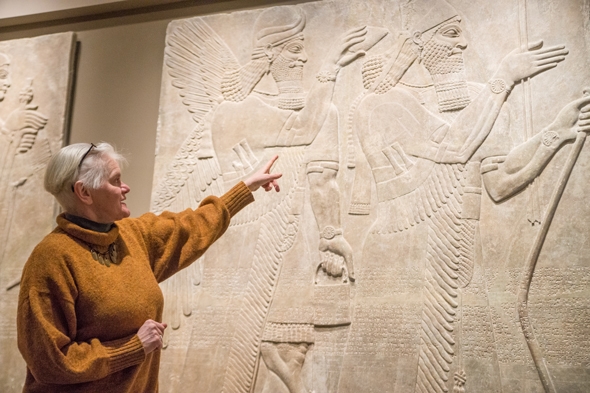The destruction of ancient Assyrian artifacts by Islamic State (ISIS) militants in Iraq prompted scholars at Dartmouth to join archaeologists and art historians from around the globe in condemning the vandalism as an assault on the world’s cultural heritage.

The Hood Museum of Art is home to six monumental reliefs from the palace of King Ashurnasirpal II in Nimrud, Iraq, dating from the ninth century BCE, as well as other Assyrian artifacts. After ISIS released a video of fighters smashing archaeological treasures in the Mosul museum, the group vowed to destroy the remains of the ancient city of Nimrud to the south.
“The vandalism perpetrated by ISIS at the Mosul museum and at the nearby Nergal Gate is a tragedy for the people of Mosul, for the people of Iraq, and, indeed, for all of humanity,” says Susan Ackerman ’80, the Preston H. Kelsey Professor in Religion.
Ackerman, who is also a professor of women’s and gender studies and Jewish studies, is president of the American Schools of Oriental Research (ASOR), a leading North American organization for archaeologists and historians who study ancient Iraq and the ancient Near East.
A joint statement from ASOR, the Association of Art Museum Directors (AAMD), the Archaeological Institute of America (AIA), and the Society for American Archaeology (SAA) deplored the destruction and called on authorities to support the archaeological community’s efforts to repair damaged works if possible, and to find and reclaim missing objects. Dartmouth Professor of Anthropology Deborah Nichols is the incoming treasurer of SAA.
“While the full extent of the damage to Iraq’s cultural heritage will only become clear after greater stability is restored, the material culture from more than 5,000 years of history is under extremely serious threat and we must take immediate action,” the statement reads.
ISIS fighters reportedly denounce the nearly 3,000-year-old artifacts as idols and thus against the laws of Islam.
According to the University of Pennsylvania Cultural Heritage Center, Iraq has some 12,000 registered archaeological sites, 1,800 of which are in ISIS-held territory. Many scholars fear that militants are also raising significant amounts of money by selling antiquities such as statues and cuneiform tablets on the black market, Britain’s Independent newspaper reports.
The six large Assyrian reliefs in the Hood collection include representations of King Ashurnasirpal II with bow and arrow, a human attendant, and winged supernatural figures called apkallu. The carved gypsum reliefs, part of the Hood collection for almost 160 years, were acquired through the agency of Sir Henry Rawlinson, a representative of the British empire in Baghdad, and Austin H. Wright, Class of 1830, a missionary who at the request of the College collected the works and arranged for their packing and transport.
“As custodians of these magnificent reliefs, we are deeply affected and saddened by the current destruction of these antiquities and monuments and also by the implications that their loss has for future students and scholars of these important ancient cultures,” says Katherine Hart, senior curator of collections at the Hood and the Barbara C. and Harvey P. Hood 1918 Curator of Academic Programming.
“It is no accident that here at Dartmouth, it is six great Assyrian reliefs that come from Nimrud that stand as the centerpiece of the Hood Museum’s entryway gallery, for when we see those reliefs, as we walk in the Hood’s door, the connection that binds us to Iraq’s cultural heritage is immediately forged,” says Ackerman.
“Now ISIS is threatening that the cultural treasures that remain in Nimrud are next on their list. I grieve for Mosul and Iraq, and for us all,” Ackerman says.
